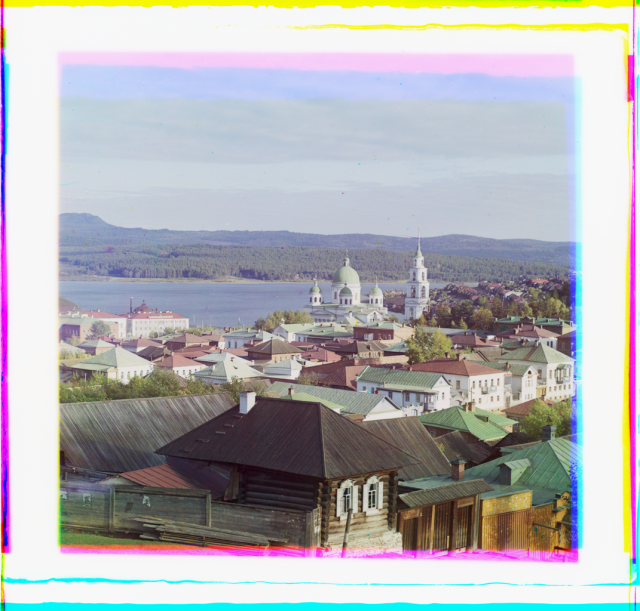
This photograph was taken by Russian photographer Sergei Mikhailovich Prokudin-Gorskii in the town of Zlatoust in approximately 1909. At first glance, it appears to be a beautiful photograph with the delightful contrast of city and countryside. However, upon closer observation and research this photograph looks to me more like a visual representation of the great divide in the Russian Empire’s social class structure.
Serfdom was an integral part of Russian societal history until the mid to late 19th century when the Emancipation Statutes of 1861 abolished (using this word lightly) serfdom. Alexander II stated five years prior to the Emancipation Statutes that, “It is better to begin abolishing serfdom from above than to wait for it to begin to abolish itself from below.” (Freeze 203) By this Alexander II meant that to avoid revolution, the government would have to start what the people (serfs) wanted and deserved. However, despite his statements of belief and desire for abolition, it was not an easy task and it certainly was not quick or without challenges.
In many ways former serfs, then called peasants, were still second-class citizens (Freeze 206). This class system within Russian society emphasizes what I am calling the ‘great divide’ in that the peasants had practically nothing compared to squires and nobles, among others. Former serfs were allowed the rights of marriage, property acquisition, and trade conducting; However, the emancipation statutes still limited and disadvantaged these peasants in that for two years after their emancipation they were forced to continue their work, they were bound together in their own separate society under the principle of collective responsibility for taxes, etc., they lost land access and they were forced to pay redemption payments (Freeze 206-207). This emancipation was not the freedom that the serfs deserved or were looking for; Rather, it furthered the sharp divide between the have’s and the have-not’s. I believe that Russian photographer Sergei Mikhailovich Prokudin-Gorskii was able to capture this dynamic in the above image of the Ai River valley.
Sources:
Freeze, Gregory L. Russia: A History. 3rd ed., New York, Oxford UP, 2009.
Prokudin-Gorskii, Sergei Mikhailovich. View of Zlatoust from the West. 1910. World Digital Library, http://www.wdl.org/en/item/5271/#q=Prokudin-Gorskii&page=4. Accessed 20 Jan. 2018.

I agree that the rural-urban divide is key to understanding the changes in Imperial Russia that lead to the revolutions in the 20th century. Check out Rachel’s post with a wonderful image of agrarian life and more reflections on the changes brought about by the emancipation of the serfs here: https://20thcenturyrussiarachelh.wordpress.com/2018/01/20/community-within-a-divided-country/
LikeLike
I really enjoyed Rachel’s post! I think it showed the agrarian life that I tried to touch on in a really great way that draws the audience in because they are actually able to see the people’s faces.
LikeLiked by 1 person
It’s interesting that the main goal of emancipating the serfs was to avoid revolution. Clearly, it didn’t work. One way to avoid the revolution might have been to decrease the extreme wealth disparity that existed after the emancipation – as you noted in the difference between rural and urban life.
LikeLike
You’re right that would have been another good way to attempt avoiding revolution. It seems to me like a revolution was kind of inevitable though with such large disparities and disdain between the classes.
LikeLike
I really like how you incorporated a quote from our text/ from Alexander II. I really like how the photo does show the divide between the classes. You see the rich, beautiful architecture in the background while in the foreground, there is mundane, cheap housing that the serfs would live in. Thank you for also going over the history of serf emancipation. You made it more interesting and easier to read than the textbook. It is hard to read over history and see how citizens were treated and the lack of rights they had.
LikeLike
I always have such a hard time reading history, not just because in a lot of cases it is dry but also because the times were so difficult and so many people had it so rough. I’m glad I was able to make the content easier for others to understand though, I always try to recreate the history in my head to remember it in a way easier than block text from a book.
LikeLike
The emancipation of serfs is a great case of “good idea, bad execution”. Serfdom as an institution showed the backwardness in Russian compared to other European countries. However, the end of serfdom opened up avenues of exploitation of the peasantry. When we get to reforms, we will see how some are too little, too late in resolving issues from emancipation. Good post.
LikeLike
I’m not a huge history buff so I have no idea but I wonder if there are any instances in which emancipation went smoothly? Emancipation in the United States certainly didn’t go smoothly and obviously nor did it in Russia..
LikeLike